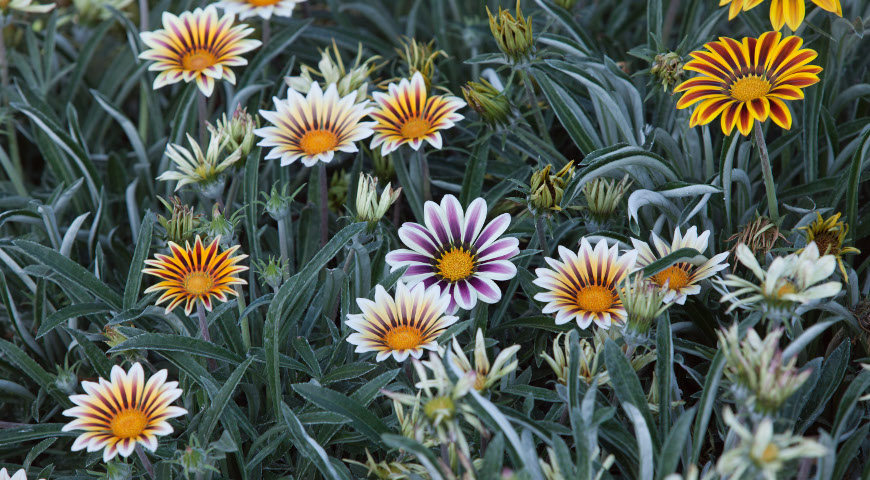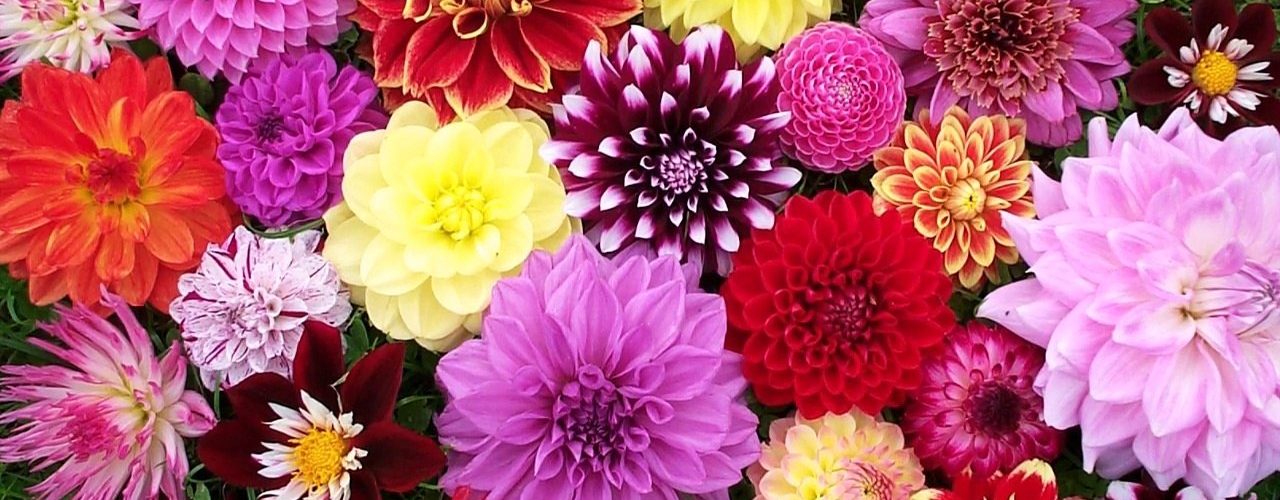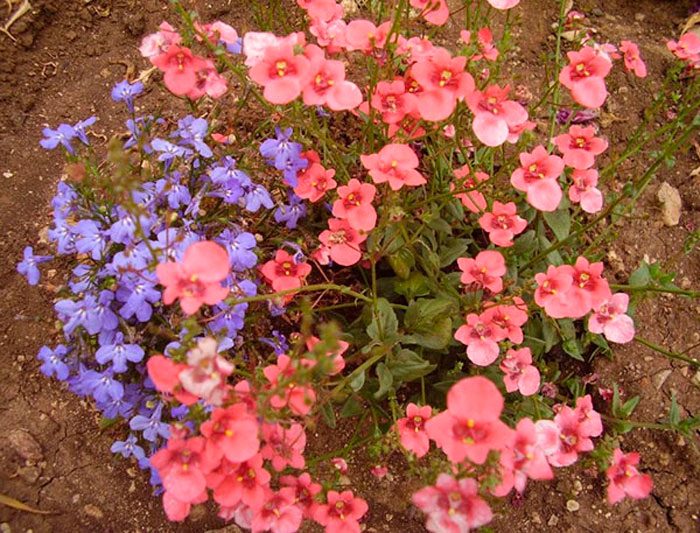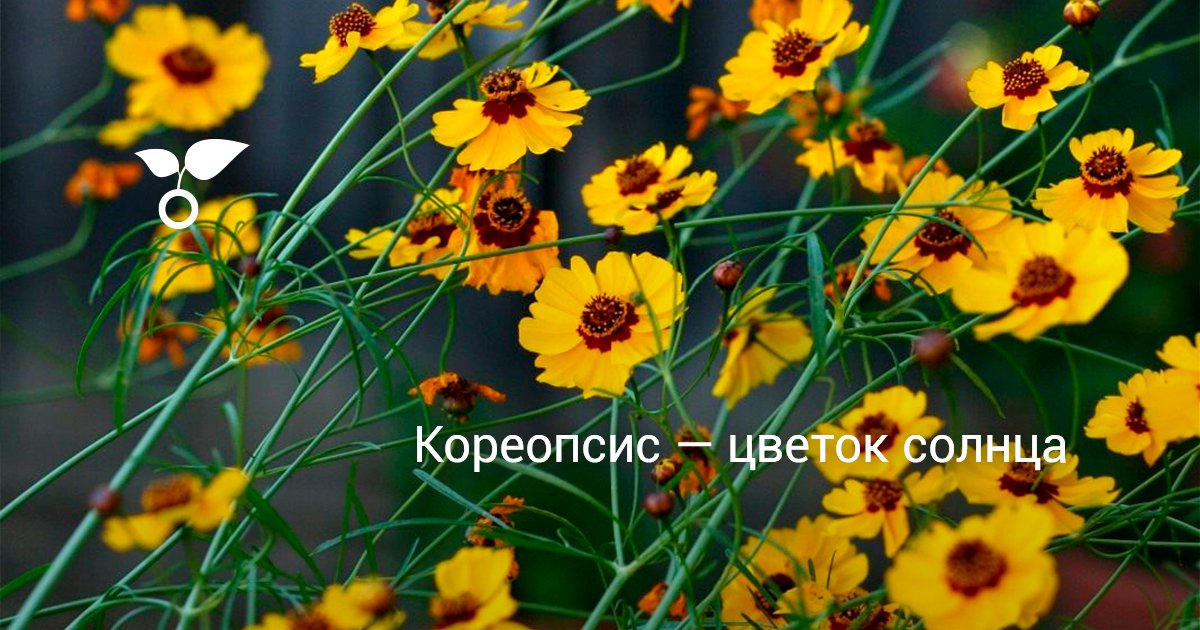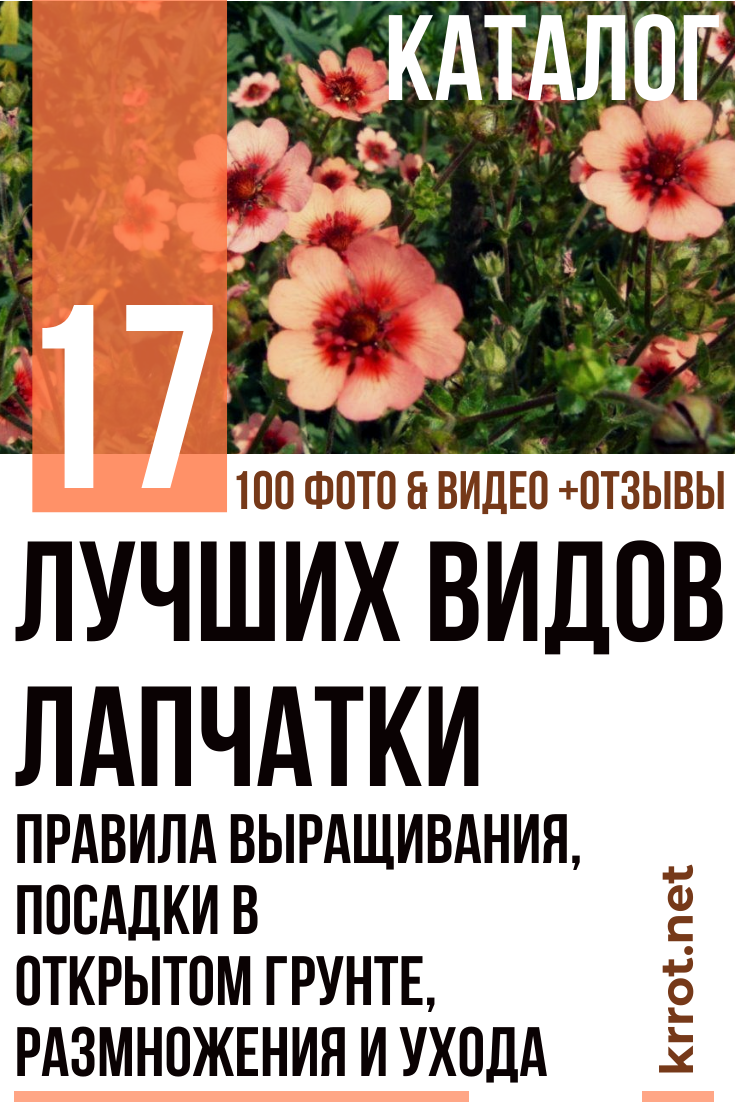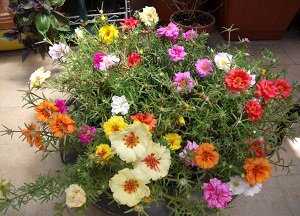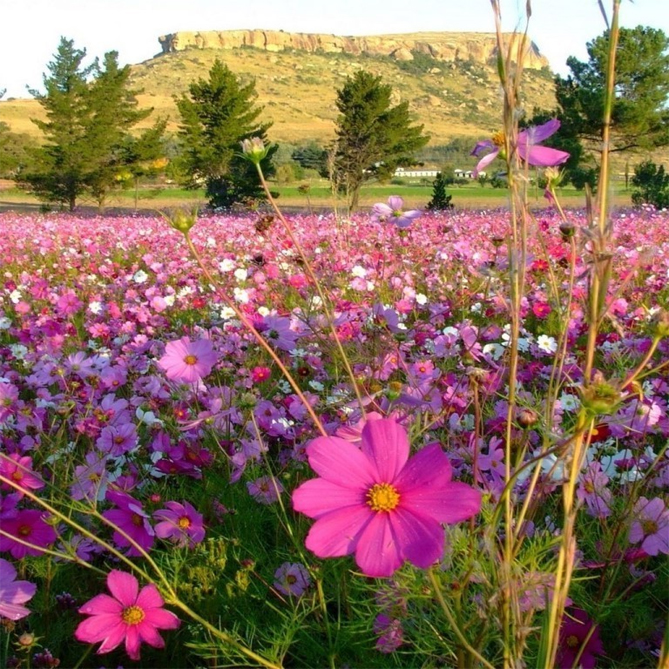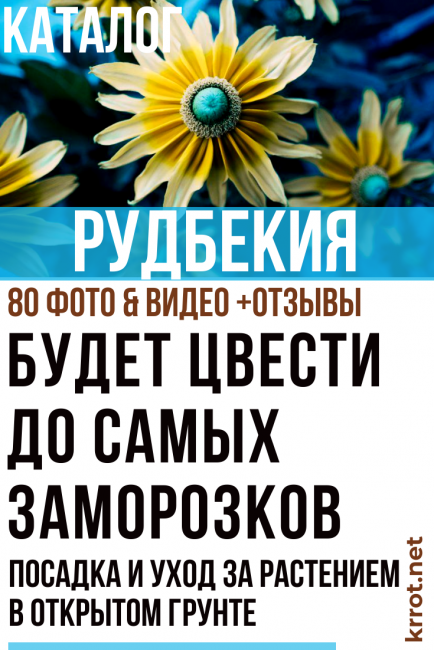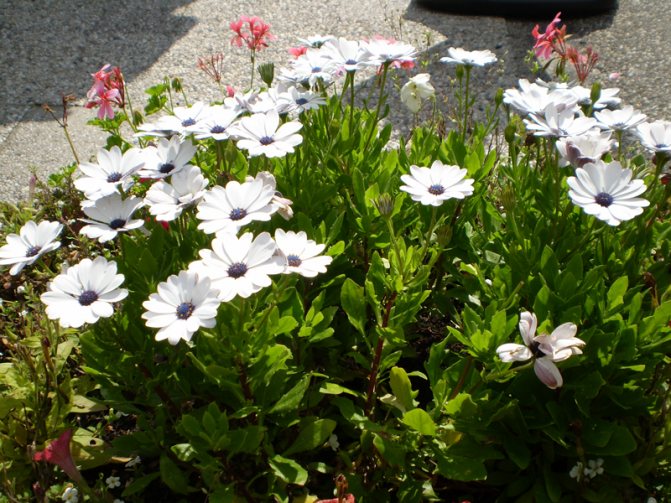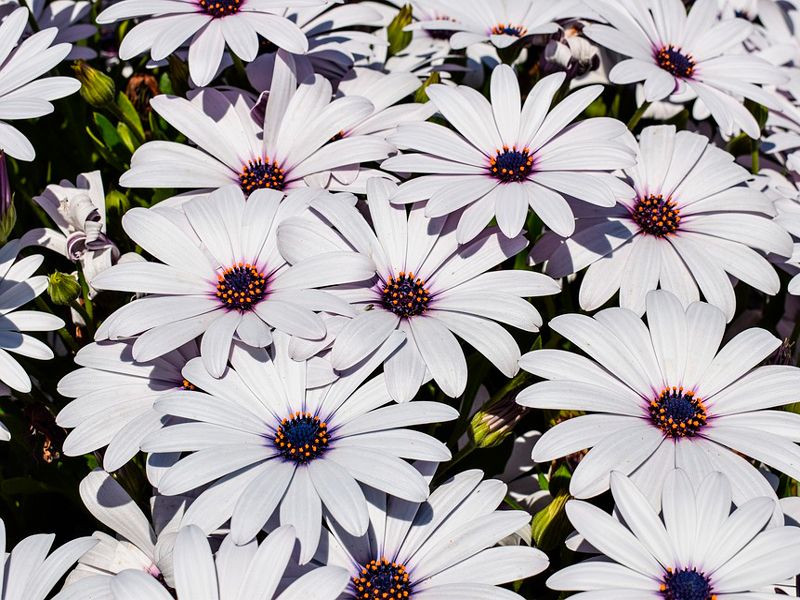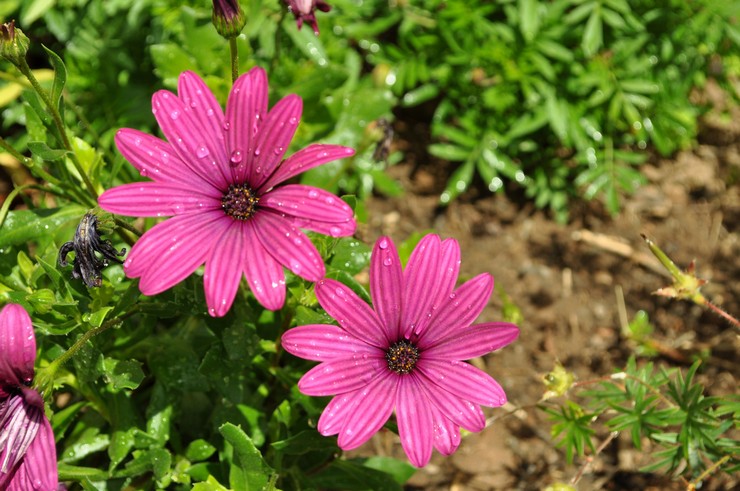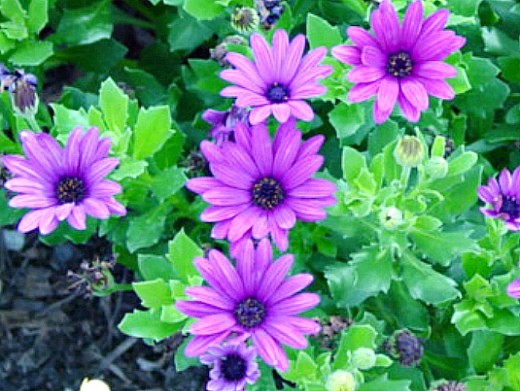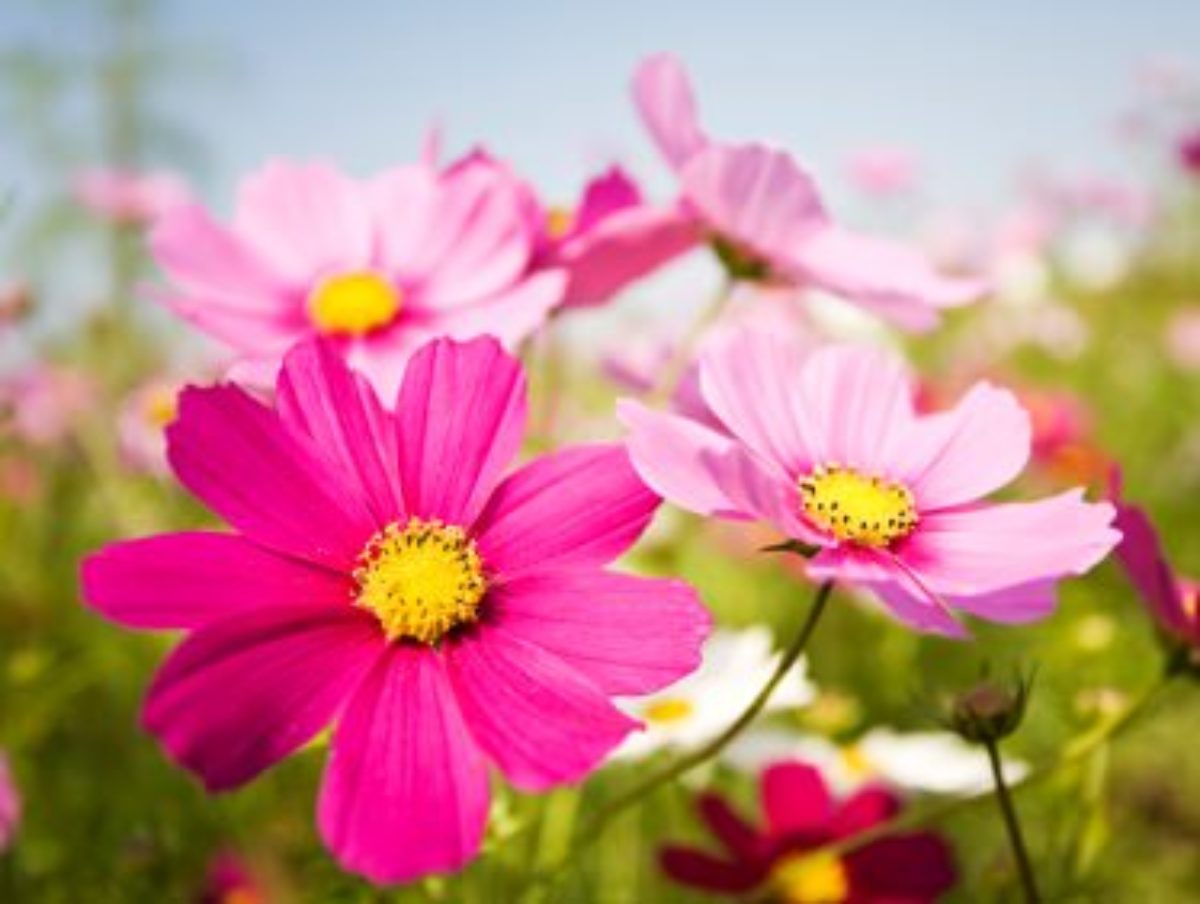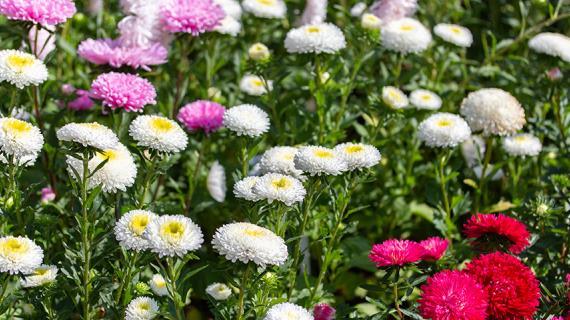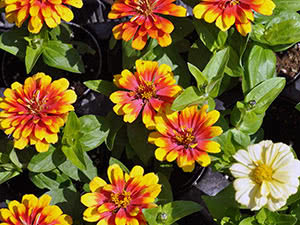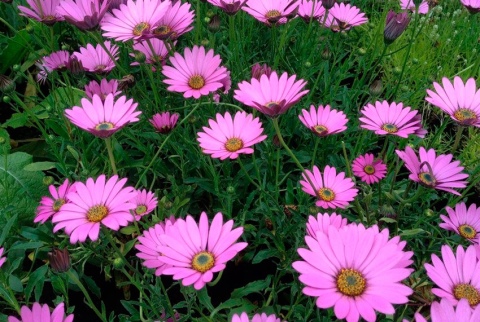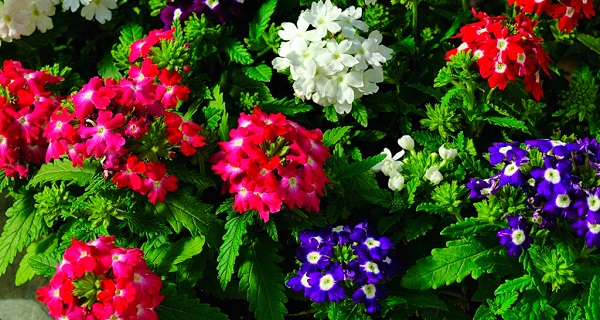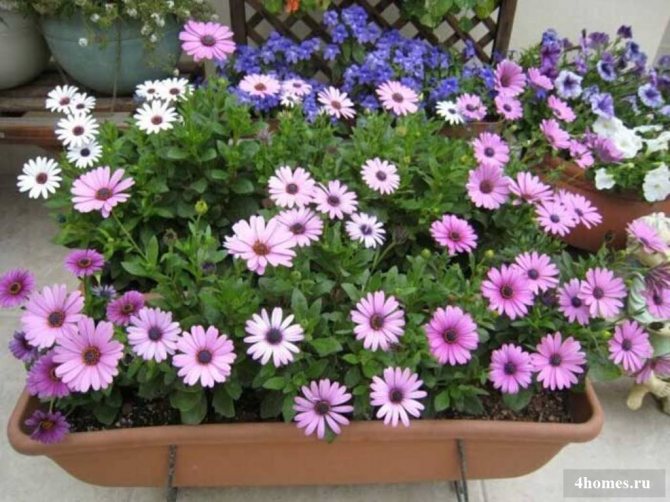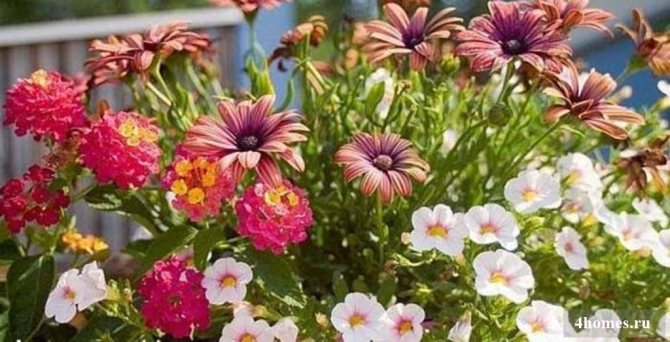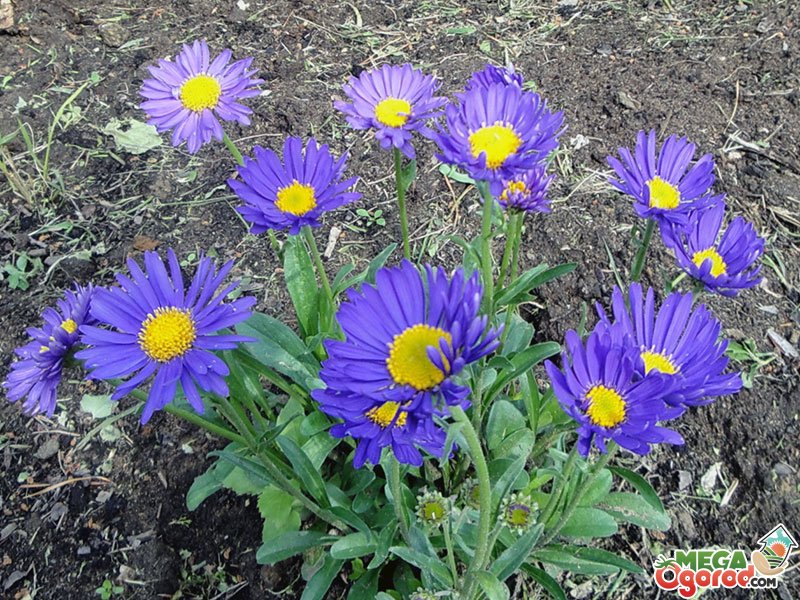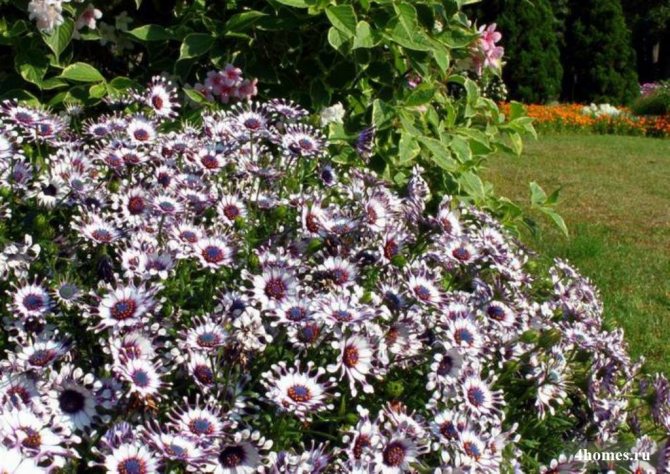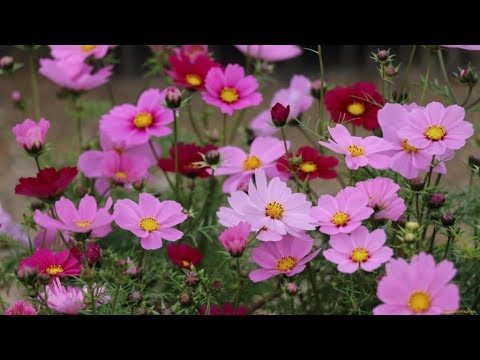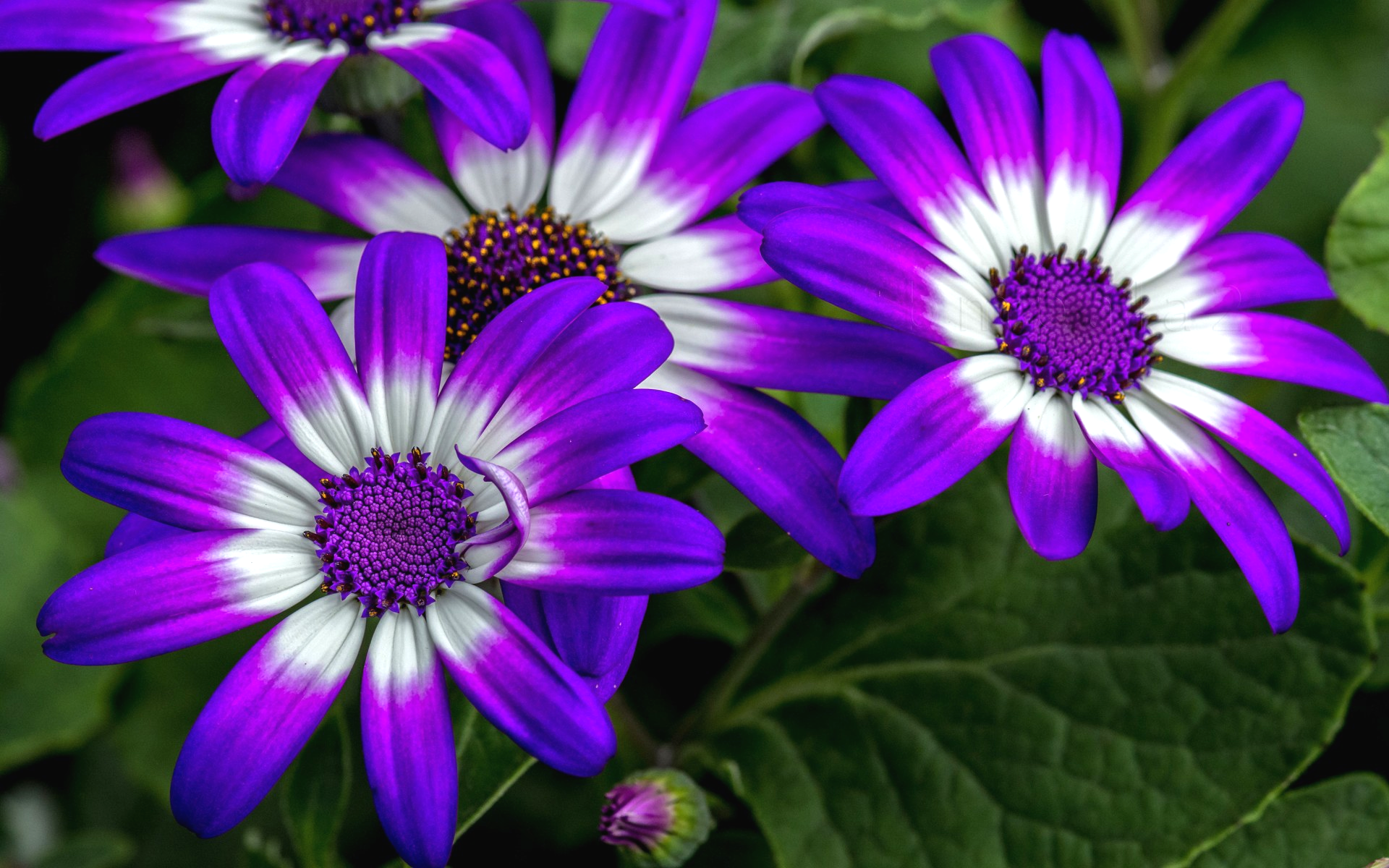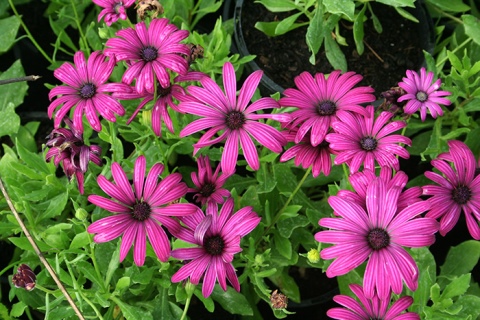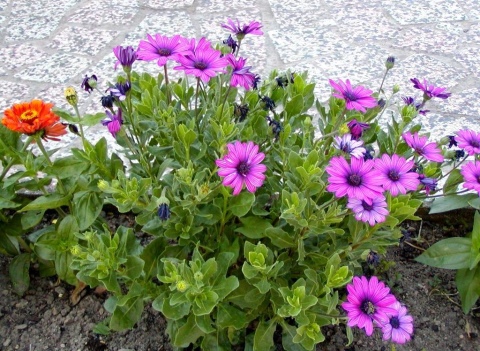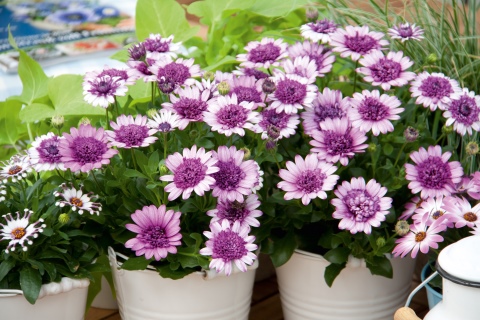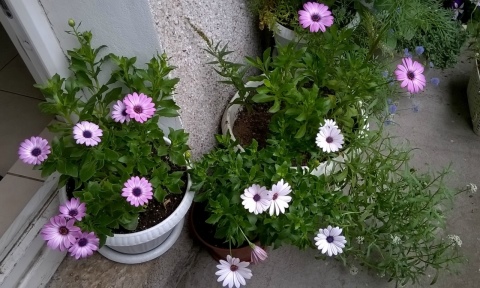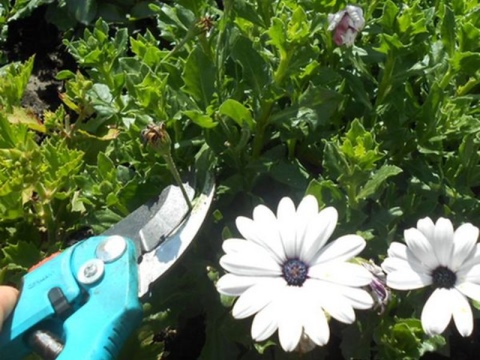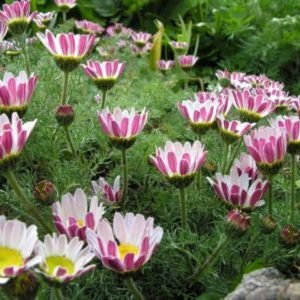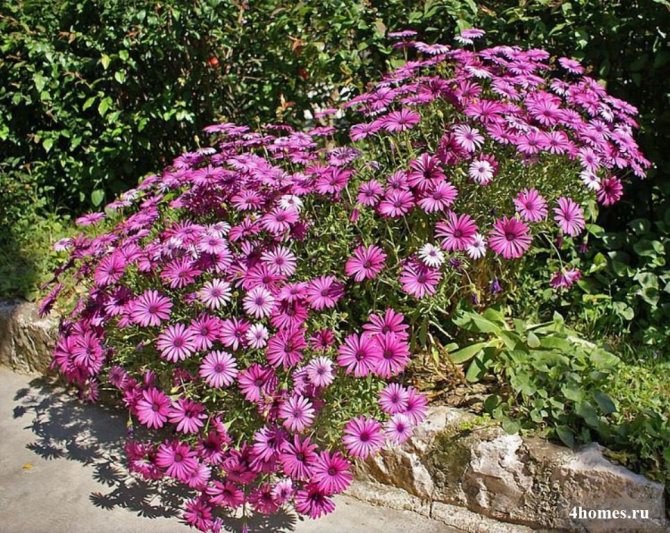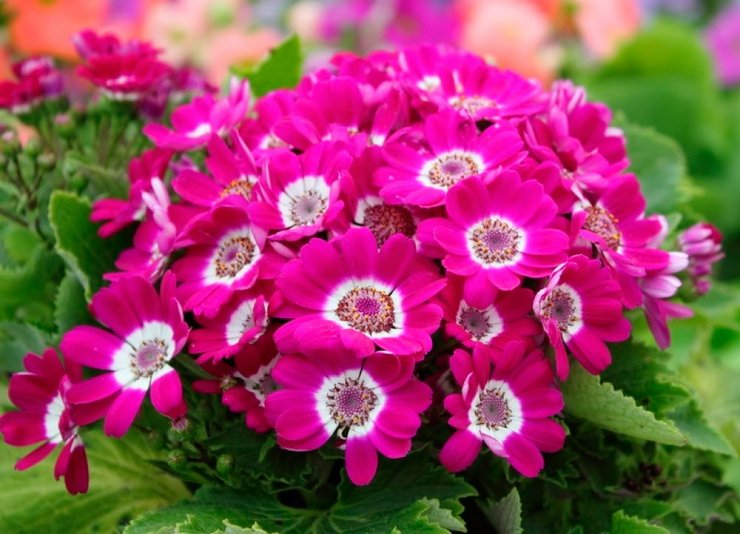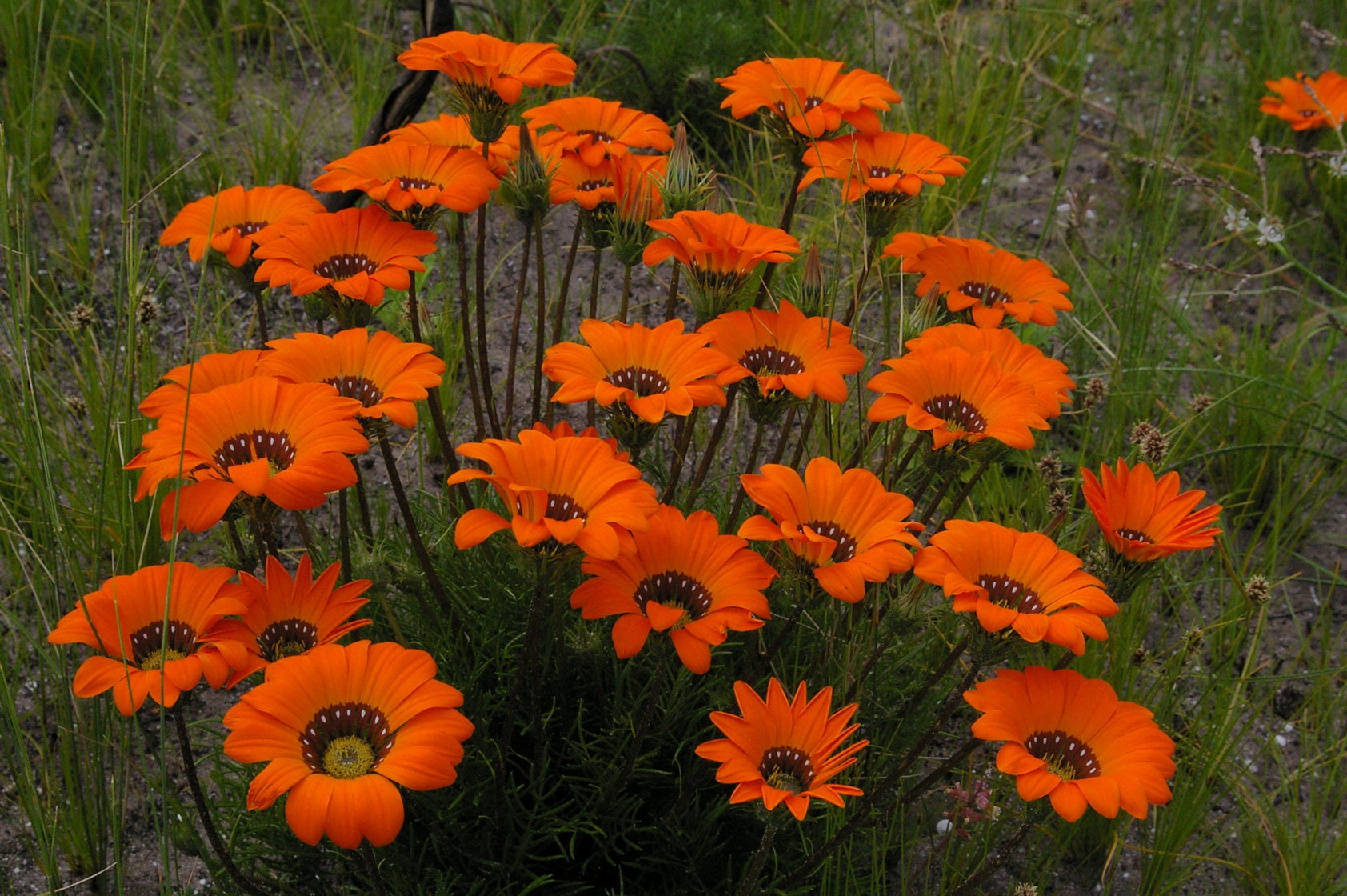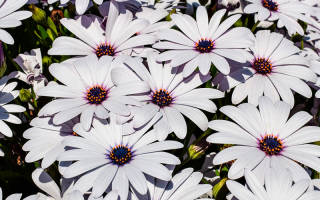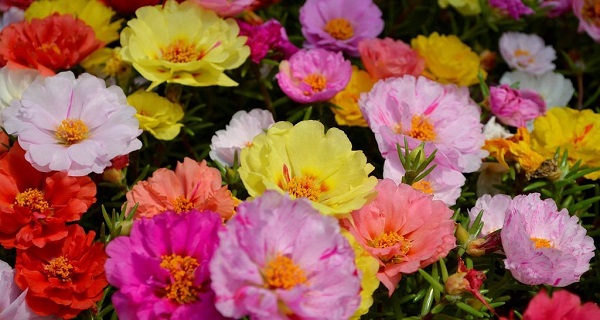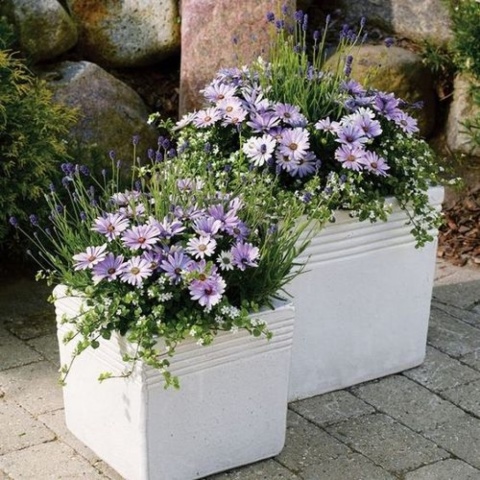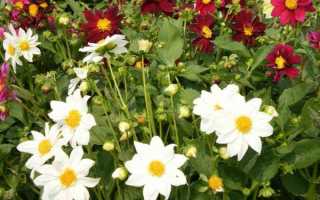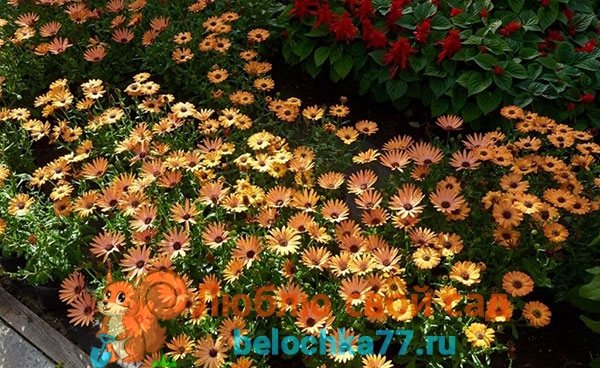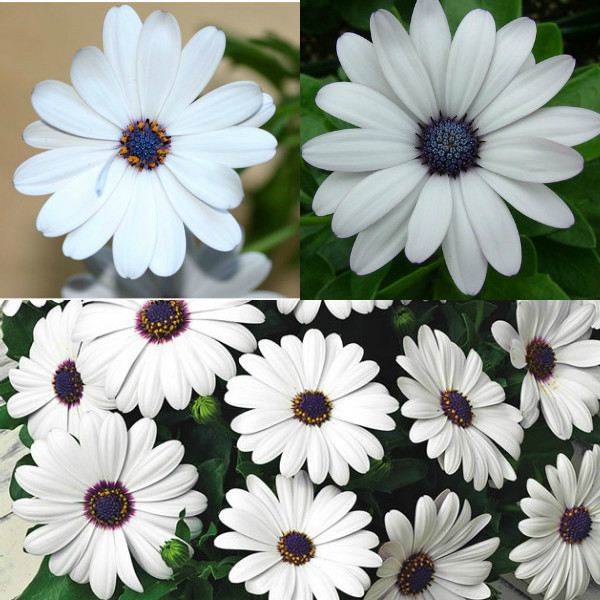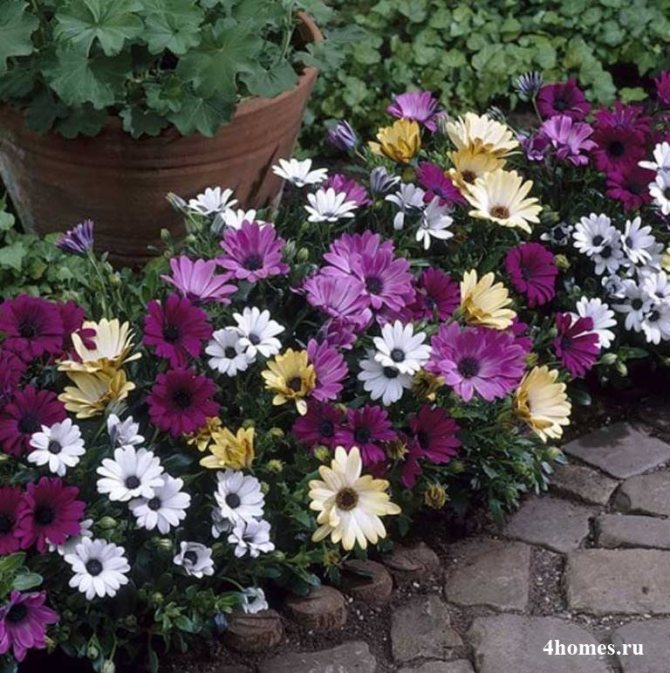Summer flower care
Osteospermum care consists of the same procedures as for ordinary plants: watering, fertilizing the soil and maintaining an appropriate temperature regime.
Watering
This plant needs regular, moderate watering. Of course, osteospermum can easily tolerate a lack of moisture in hot weather, but it is better not to conduct such experiments. When caring for a plant, do not overmoisten the flower, because this can completely destroy it. During winter dormancy, watering should be done quite rarely, avoiding the drying out of the soil in the pot.
Temperature range for African chamomile
Osteospermum can grow in regions with low air temperatures. However, in order to protect the plant, it is recommended to carry out hardening procedures when growing seedlings and caring for it with the appearance of the first leaves. To do this, a pot with plantings can simply be placed in a room with a low temperature or taken out for a short time to the balcony. At first, the lowered air temperature should be at least 15 degrees and, gradually decreasing, it can be brought to 12 degrees.
Osteospermum feeding
It is necessary to fertilize osteospermum with fertilizers during the period of bud formation before the beginning of the flowering process. When caring for flowers, applying mineral fertilizers to the soil every 2-3 weeks will extend the flowering period of the buds. Remember to remove dried osteospermum flowers that may interfere with normal growth.
Diseases and pests
Surprisingly, this plant is well resistant to various diseases and, while caring for it, you should not worry about methods of protection. In rare cases, aphids can affect osteospermum. Much more dangerous for him is considered to be abundant soil moisture and planting in a highly shaded area.
Pinching a Cape Daisy
Caring for osteospermum includes a procedure such as pinching. This will stimulate the formation of new branches in the plant, as well as help form an attractive bush.
Osteospermum stands out among other ornamental plants for the abundance of varieties and a varied palette of shades. Growing and caring for this plant is not such a difficult task, and this is what will allow our pet to become a real favorite among flower growers.
Common questions
Ask an expert
The lower leaves of the seedlings curl downward - is this normal? Curling of the lower leaves may indicate several problems, including a lack of lighting (accompanied by a loss of turgor) or decay due to excessive watering (can develop against the background of the appearance of black spots). In some cases, such a signal is regarded as a natural aging process or the need for fertilization.
Is it true that you can speed up the germination of seeds by placing them in the refrigerator? Experienced gardeners often resort to stratification - placing seeds in a cold or humid environment with limited oxygen access. Such measures are needed in order to launch all the necessary mechanisms for seed growth.
Is it possible not to soak the seeds before planting? An alternative to stratification can be a short soaking of seeds in growth stimulants such as "Epin-Extra" or "Zircon". The latter can be purchased at any florist or garden department.
Will osteospermum continue to bloom in the house in the fall? Some gardeners prefer to grow osteospermum as a perennial plant, taking it into the house at the first steady cold snap in order to return the flower to the garden next spring. As for flowering at home, it is possible, but it is certainly not necessary to expect a lush harvest, since the conditions are far from being able to grow in open areas.
Features of planting and care in the open field
Osteospermum is considered to be a fairly easy plant to care for. The main thing is to plant it in places with good illumination. This is due to the fact that when in the shade, it will not bloom as abundantly as everyone expects of it. In addition, the buds will be closed for a longer time.
In principle, this plant is not particularly whimsical to the density of the soil, but it is better to plant on loose soil, enriched with nutrients and having a neutral or slightly acidic balance. To correctly determine the planting density, you need to take into account the height of a particular variety. Typically, the spacing between bushes ranges from 0.3 to 0.5 meters. If you want the young plant to branch better, its top must be pinned.
Osteospermum is able to withstand cold temperatures down to -5 ° C and quite intense heat. The first flowering period begins in June. There is a short break during hot July. After that, in mid-August, when the heat has already subsided, the second wave of flowering begins, in intensity not inferior to the first.
Of the features of osteospermum, planting and care in the open field, with a photo of which we describe, it is worth highlighting their watering. In no case should this plant be flooded, otherwise root rot may develop. Water it in moderation. It is better not to add even a little water than to add too much. This plant is quite capable of bringing even a slight drought. However, this will result in a smaller size and number of colors.
The optimal watering regime is considered once every three days. In hotter weather, the frequency can be increased slightly.
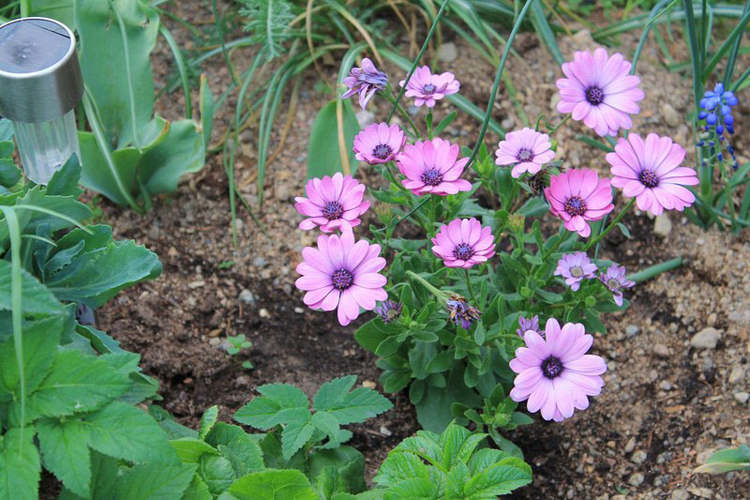
After planting in early May, the flower must be fertilized twice a month. In this case, it is necessary to alternate complexes based on organic matter with the same, but based on minerals. Young shoots of this flower can suffer from a lot of weeds, so it is highly recommended to weed them regularly. In osteospermum of high varieties, it is necessary to tie up the stems. Otherwise, wind and rain can destroy this beautiful flowering bush. Withered inflorescences need to be removed in time to make room for new buds.
Planted in open ground, osteospermum will survive well until spring if the temperature does not drop below 10 ° C. At the same time, both shoots and foliage will be preserved. If in the region where it is grown, severe frosts are not uncommon, then the plant must be dug up for the winter and transplanted into pots.
Osteospermum perfectly withstands transplantation and recovers quite quickly after it. In the winter season, these plants can be kept in temperatures ranging from +5 ° C to +10 ° C. Moreover, they should be in a well-lit place. Watering will need to be significantly reduced. With the onset of spring, the bush can be returned to the soil or taken out to the veranda without taking it out of the pot.
If you properly care for the "African chamomile" and water it moderately, then it will not suffer from diseases or parasites. Therefore, it is strongly recommended to follow all the recommendations for caring for this flower, and it will delight with its beauty for a long time.
Reproduction
The flower propagates vegetatively and by seed. It is better to grow a varietal hybrid from a cut, then the plant will inherit all species characteristics. Gardeners do not collect seed material, but prefer to purchase it in specialized departments or on web resources. Seeds retain their germination capacity for 3 years.
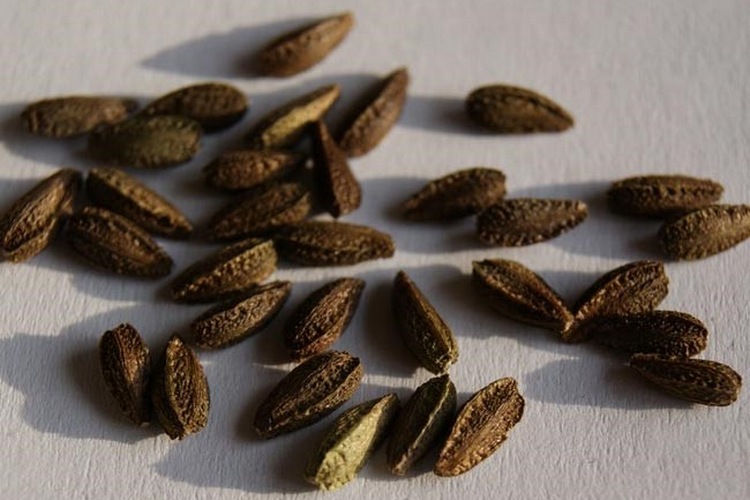
Osteospermum, seeds. They are protected by a dense shell, for abundant flowering they are recommended to be soaked in a biostimulant solution
Osteospermum: growing from seed - when to plant seedlings?
You can sow a flower:
- in cups;
- general capacities.
The seeds are pressed or covered with a 2 mm layer of soil. The container must be covered with a film, removed to heat. Open it after germination.
Most often, the reproduction of osteospermum is practiced by growing from seeds - when to plant seedlings, gardeners decide on their own. Planting dates are the same as for asters: March - early April. The March seedlings will bloom in June, the April seedlings in July.
Planting seedlings in open ground
Shoots are transplanted to a permanent place after recurrent frosts. Two weeks before planting, the plants are hardened: they are taken out into the street during the day. The interval of stay is gradually increased to 6 hours. After hardening, the shoots will steadily endure small nighttime cold snaps.
Propagation by cuttings
For cutting planting until spring, the uterine bush is kept warm: at home or on a glazed loggia. The recommended winter temperature is + 12-15 ° C. The earthy lump is moistened, not allowed to dry out completely.
The stalk is made from the top of the stem. In water, it quickly takes root, takes root well in loose nutrient soil. Non-flowering young shoots are taken from plants growing as indoor flowers.
Important! Cuttings are broken off a month before planting so that they take root well.
Osteospermum: growing in pots
For the home, they choose undersized and medium-sized species. The winter break is done from the end of December to March, while the daylight hours are short. In the spring, the plant is loosened, fed, watered with fertilizer once a week.
Important! During the budding period, the bush is sprayed with an "ovary" - a mixture of amino acids
Growing osteospermum from seeds at home
For planting, they immediately select a pot in which the plant will remain for several years. It is ¼ filled with expanded clay, and the top is filled with a loose soil mixture. The bush is grown as seedlings, only they are not transferred to open ground, but left on the windowsill. In the summer, the plant is taken out into the open space.
Choosing a container for planting
A planter for a flower will not work, you need a pot with a hole to drain the water. The root system extends to ½ the diameter of the bush, the capacity should be wide.
Osteospermum: planting and care
There are two ways to grow osteospermum: sowing seeds and cuttings. It is necessary to sow osteospermum seeds on seedlings, the photos of which have already been seen above, somewhere in the last days of March or in early April. For the process to be as effective as possible, it is necessary to use containers or peat pellets filled with a mixture, the main components of which are peat and sand. For faster seed growth, it is recommended to place them in a damp cloth for several hours before sowing. However, in no case should the seeds be soaked, because this will affect the seeds very negatively. In order not to destroy the plant in the bud, the following recommendations must be strictly observed:
- Place one seed on a damp surface, which must be deepened 5 millimeters into the soil with a toothpick. Do the same with other seeds.
- Remove the crops produced in a warm room, where the temperature regime will be in the range of 20-22 ° C.
- After about a week, the first seedlings should appear, which need to be transferred to a place with high light levels.
- If seedlings are grown inside a container, then, when two or three leaves are formed, it is necessary to pick them in separate containers. The main thing is not to forget to deepen part of the stem.
- When growing varieties with a large stem height, after transplanting the plant, it is imperative to pinch a little. This is necessary so that later they have a larger number of flowers. In addition, it will prevent the seedlings from growing too much in height.
- When the last month of spring comes, it is necessary to start hardening the seedlings. This should be done from the very first days of May. Correct hardening is done in a room with a systematically opening window or by moving the seedlings to the balcony. At first, this procedure should not last longer than a quarter of an hour.Over time, the duration of hardening must be increased.
For clarity, how the coolness of osteospermum is carried out when grown from seeds - the photo can be seen below.
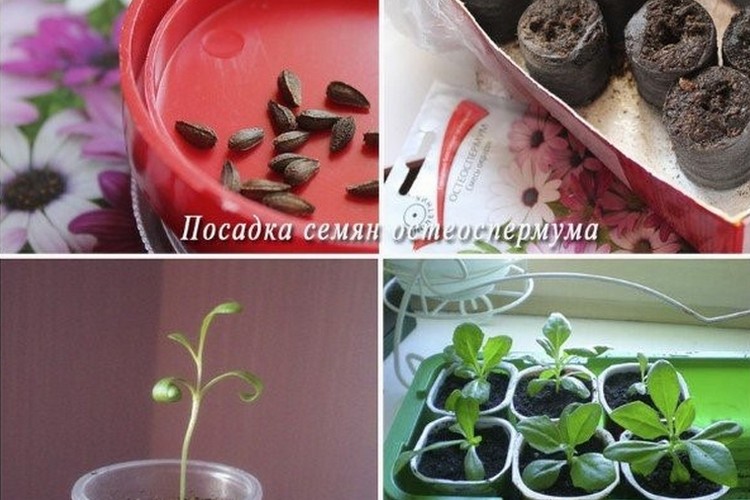
For grafting, osteospermum bushes are used, which were dug out in the fall and stored in a special place until the arrival of spring. With just one bush, you can get several beautiful annuals at once. For correct grafting, the following recommendations must be observed:
- Using a sharp knife, cut the cuttings five to seven centimeters long.
- Remove bottom foliage.
- Insert the pieces into a container with a damp substrate, which can be used as moss, fart or vermiculite with hydrogel.
- Cover the cuttings with a glass container or plastic wrap and put them in a well-lit place with a comfortable temperature.
- For ten days, they need to be ventilated, and the soil should be systematically moistened.
- After that, it will already be seen which of the cuttings have taken root.
For clarity, how the planting and care of osteospermum is carried out - the photo below.

Planting osteospermum in open ground
Under natural conditions, the bushes reproduce by self-seeding. Tropical culture is afraid of return frosts, sudden changes between day and night temperatures. In the southern regions, on glazed balconies, loggias, you can often see osteospermum, growing it in decorative outrigger pots, on balconies is not uncommon. In the southern regions, the flower grows like a perennial in the open field.
Growing osteospermum from seeds
The seeds are immediately embedded in the soil, slightly pressed into them so that the birds do not eat them. It is convenient to plant large seeds one at a time, observing the interval between the bushes from 20 to 40 cm, depending on the height of the shoots. For seedlings, the seed is laid out on the ground in greenhouses, hotbeds, the soil is well moistened, covered with a film - they create tropical conditions.
Important! With a strong deepening of the seed, the sprout may die. Some growers prefer to plant peeled seeds; before sowing, peel off a strong skin or make a crack on it for water to enter.
What is needed to plant osteospermum? The shrub grows well, blooms profusely on neutral soil, fertilized with humus, mineral fertilizers. For an unpretentious osteospermum, planting and care is reduced to weeding, watering.
Optimal site for osteospermum
African chamomile loves the sun, tolerates partial shade well. Like all Asteraceae, the plant is prone to root rot. Flooded areas will not work. The earth should warm up well. With a high groundwater table, drainage is required.
How to feed osteospermum for lush flowering
To grow full-fledged bushes, handfuls of humus and ash are added to the planting holes. During the budding period, foliar dressing (spraying) with complex fertilizers for indoor plants is recommended. Minerals are diluted according to the instructions, then the volume of water is doubled so as not to burn the greens. You can feed the flowers at 3-week intervals. The prepared solution of superphosphate, potassium nitrate is added to water for irrigation, a concentration of 1: 3 is made (one part of the fertilizer is diluted with three parts of water).
Important! If you pinch the upper shoots, lateral peduncles are massively formed
Osteospermum: how to preserve in winter
In regions where the temperature does not drop below -10 ° C in winter, the bushes are well preserved under cover of branches, under a layer of peat. In temperate latitudes, the bushes are transferred to pots by the transfer method, brought into the house. The plant recovers well after transplanting. The bush will bloom until the end of December, then you need to pause, move the flower to a cool place, and reduce watering.


